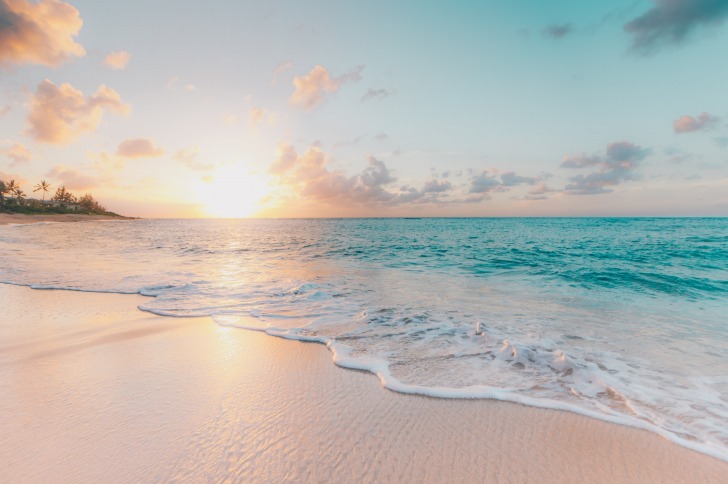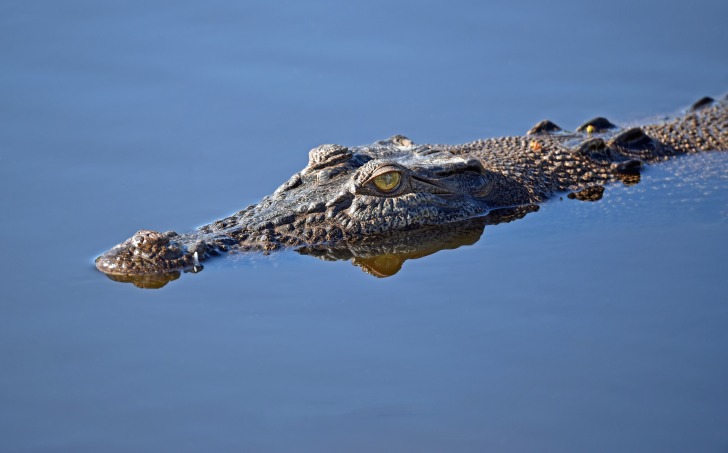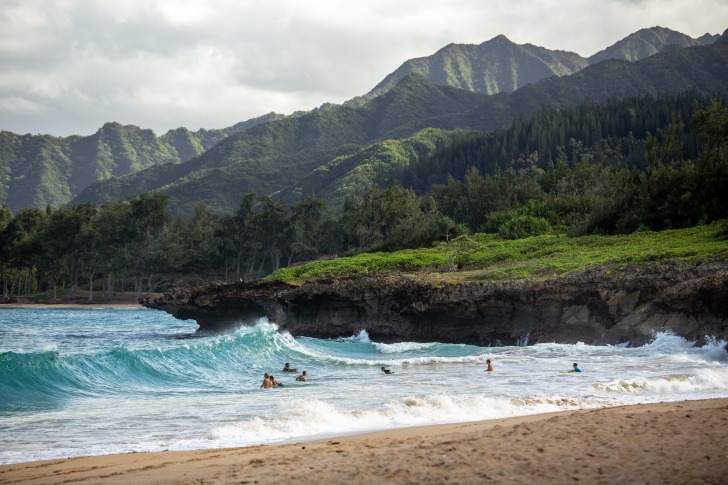There are millions of alligators in the United States – many of which make their homes in areas like Florida.
And because of that, it’s easy to assume that alligators would live and thrive in any balmy, wet area – including Hawaii.
Is this true?
Do alligators actually live in Hawaii?
Let’s take a look and find out.

Contents
So… Are There Alligators in Hawaii?
In short, yes – in the Honolulu Zoo and some animal shelters.
However, you shouldn’t see a single alligator roaming free in or out of the water.
And that includes Alligator Rock Beach, which is named for its shape.
There are no alligators there.
Alligators are not native to Hawaii – meaning that they have no reason to be there.
Of course, there are many animals not native to a place that end up there, right?
Usually, this happens for one of two reasons: either they travel there on their own or they are brought there.
So how do you know that neither of these two things happens?
Let’s start with this fact: Hawaii is a set of islands that aren’t exactly swimming distance from the mainland.
Most water creatures that make their way to Hawaii do so by catching a ride – inadvertently – on a current.
However, these are light enough to float – alligators are not.
Alligators are pretty heavy and large, so it’s not really possible for them to float all the way to Hawaii.
And therefore, alligators don’t get to the islands on their own.
The next option is for people to bring them – which is pretty unlikely since it’s illegal to do so.
You see, Hawaii considers alligators a threat to the fragile ecosystem and to the humans that live and visit there.
As the government is very invested in protecting the ecosystem, they simply won’t allow anyone to bring alligators to the islands.
This is not to say that people won’t try to find a way to smuggle them in, but Hawaii is committed to getting rid of them if one is found.
When possible, they’re caught and either sent to an animal shelter or zoo, or they’ll be exported.
The bottom line is that the Hawaiian authorities – as well as the locals – will not let any alligators that are sneaked in go unchecked.
There was one found wandering around in the 80s that was believed to be a former pet – it seems it grew too large for containment and was released into the wild.
The authorities searched for it but couldn’t find it initially.
Later they located it, but they discovered it had been shot – presumably by a local.
Alligator Species in Hawaii
Again, there are no alligators in Hawaii, so there are no species to speak of.
Is It Safe to Swim in Hawaii?
Let’s start with one basic fact: swimming anywhere poses a risk.
In fact, in the US alone, up to 4,000 drown every single year in all types of water.
And Hawaii is no exclusion, with about 40 drownings a year among residents and over 80 among tourists.
That being said, Hawaii has nearly 1.5 million residents and around 10 million visitors each year, the percentage of drownings is considered low.
Hawaii takes the potential dangers of drowning seriously, though, and posts warnings when conditions are unsafe for swimming.
Basically, if you follow those warnings and basic safety precautions, your risk of drowning is greatly reduced.
However, drowning is not the only potential danger of swimming in Hawaii.
No, you don’t really have to worry about alligators in the water, but there are other dangerous creatures.
Sharks are a definite presence in Hawaiian waters – specifically tiger sharks.
Occasionally, there are also white sharks, some species of hammerhead sharks, and a few others.
To be fair, though, there have been less than 10 people died from a shark attack in Hawaii since 1828.
And like the dangers of drowning, Hawaii understands the dangers of sharks.
That’s why guidelines, warnings, and tips are given to help avoid these attacks.
Following these along with basic shark precautions will help minimize any potential for danger.
Sharks aren’t the only predators of the ocean to beware of in Hawaii, either, as barracuda and sea snakes are an issue.
There also happens to be a poisonous snail – the Cone Snail – which has a beautiful shell.
However, it’s dangerous to pick up.
If there is a live snail in that shell, it will attack you.
The best way to avoid that is to become familiar with how it looks so that you don’t pick it up during strolls on the beach, but it probably won’t bother you in the water.
And there are the awesome wave breaks to contend with – yes, they are great for surfing, but they can also cause injuries and more.
In short, there are specific dangers to swimming in Hawaii, but there are dangers to swimming anywhere.
And truthfully, the chances of tragedies like car accidents occurring are higher than possible swimming incidents.
So yes, it is safe to swim in Hawaii, as long as you follow precautions and use common sense.

Interesting Alligator Facts in Hawaii
There has been a story circulating about Hawaii importing nearly 200 saltwater crocodiles and alligators to control the shark population, but this story is unfounded – and a bit outlandish.
For one thing, native Hawaiians have a deep reverence for the shark or mano.
Some even believe that ancestors who have passed took on the form of a shark, becoming the family’s ‘aumakua.
So the idea of bringing in a predator to kill such a revered being is not something that would be acceptable.
Another thing is that in a fight, neither a crocodile nor an alligator can defeat a shark.
This is true for many reasons, such as the fact that a shark is bigger, faster, and has a much more powerful bite.
So this rumor of Hawaii importing alligators and crocodiles for such a job is one not backed by fact, science, or an understanding of Hawaiian culture and belief systems.
Alligators vs. Crocodiles
So we’ve established that there aren’t – or shouldn’t be – any alligators in Hawaii, but what about crocodiles?
And how can you tell the difference between these two animals, anyway?
Alligators and crocodiles can easily be mistaken for one another when you don’t know what to look for, but they do have some distinct differences.
Let’s start with their color. Crocodiles tend to be lighter and more green or brown.
Alligators, on the other hand, are usually a dark color – almost black.
Another noticeable difference is their snouts. Crocodiles have a snout that looks like a “V,” while alligators’ snouts resemble the letter “U.”
You can also often tell where you locate one.
Crocodiles enjoy saltwater and a mixture of saltwater and freshwater.
Alligators, on the other hand, tend to stick to fresh water.
Both creatures can be dangerous, but crocodiles tend to be so at all times.
Alligators, on the other hand, typically only get aggressive when they feel threatened.
That being said, don’t just hang around and check their demeanor to determine which one you’re dealing with because you might not live to tell the tale.
Now, the good news is that – like alligators – you shouldn’t see any crocodiles in the wild in Hawaii, as the government considers them an invasive species as well.
3 Safety Tips for Swimming in Alligator-Infested Waters
Now, as stated, you should be safe from alligators in the water in Hawaii, but the same isn’t true everywhere.
If you happen to be in an area of the US that does have alligators, you might want to swim in the waters.
Swimming is good exercise and definitely great for recreation, but you’ll want to take care of alligators lurking nearby.
To be honest, it’s best to avoid alligator-infested waters – or any waters infested with dangerous creatures.
But if you’re going to do it anyway, be sure to follow the safety tips below.
1. Avoid Danger Zones
Many areas that are known to be infested with alligators will have warning signs that tell you which areas to avoid in the water.
If you don’t see any signs, though, you can still keep an eye out for specific things.
For example, if you notice heavy vegetation, be aware that it’s a good place for alligators to hide.
And the water’s edge – especially from dusk to dawn – can be dangerous, since it’s prime feeding time.
2. Avoid Swimming Alone
It’s never a good idea to swim alone because anything can happen.
This is especially true when there is potentially dangerous wildlife in the area.
Having a swim buddy with you gives you an extra set of eyes to keep a watch for any alligators in the area.
It also helps because if something should occur, your buddy can call for help.
3. Don’t Act Like a Threat or Feed Creatures
Alligators are typically shy creatures – despite what TV and movies show.
They usually don’t randomly attack humans – unless they think there is a reason.
For example, if the mommas think you’re encroaching on their nest and endangering their babies, they’re likely to at least try to scare you and run you off.
And they are more likely to come to the area you are swimming in if there is food present – so don’t try to feed any of the water life.
Summary
As you can see, you should not encounter any alligators in Hawaii except at a zoo or animal sanctuary.
If you do happen to see one, all you need to do is call the authorities and they’ll take care of it.
Hawaii Safety Overview
READ THE FULL REPORT: Hawaii Safety Review
Safety Index:
- OVERALL RISK: LOW
- TRANSPORT & TAXIS RISK: MEDIUM
- PICKPOCKETS RISK: MEDIUM
- NATURAL DISASTERS RISK: HIGH
- MUGGING RISK: LOW
- TERRORISM RISK: MEDIUM
- SCAMS RISK: MEDIUM
- WOMEN TRAVELERS RISK: MEDIUM
Frequently Asked Questions
Do alligators smell blood?
Yes, they can definitely smell blood.
If you have any cuts or are bleeding from anywhere, it’s best to stay out of the water, especially if you know alligators – or sharks, for that matter – are in the area.
Can a person outrun an alligator?
Not likely – especially not a grown one.
Alligators can move up to 35 MPH, which is pretty fast.
Granted, they can only move at this speed for a short time, but it can definitely be long enough to catch you.
Therefore, unless you can move as fast as a car, running is probably not going to work.
So what do I do if I see an alligator?
Well, don’t run – that will make you seem like a threat and make the alligator react.
Instead, back away slowly to show that you are no threat.
And just in case you run across any babies, don’t decide it’s a good idea to pet them or pick them up.
Alligator mommas take care of their young, so you can bet she’ll be close by and be ready to protect her babies.












In general, swimming in Hawaii is safe as long as you follow basic safety precautions and warnings.
And if you do happen to be in an area with alligators, be sure to avoid danger zones, swim with a buddy, and don’t act like a threat or feed any creatures.
Overall, Hawaii is a beautiful place to swim and enjoy the ocean – just be sure to do so safely and responsibly.
Alligators are not native to Hawaii and it is highly unlikely that they would be able to survive and thrive in the islands due to their distance from the mainland and strict regulations on importing animals.
Alligators are not native to Hawaii and it is illegal to bring them into the state, so there should be no reason for any alligators to be in Hawaiian waters.
However, if you do happen to swim in an area with alligators or other dangerous creatures, make sure you follow safety precautions such as avoiding danger zones, swimming with a buddy, and not acting like a threat or feeding wildlife.